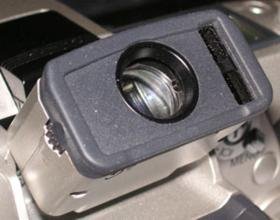Viewfinders
Viewfinders
What you see looks like what you get
What you see through a viewfinder is your subject. What you don't see through a viewfinder is the resulting picture. This distinction exist because a camera's metering system is different from our eye's way of seeing. A photographer's experience is the best guide for knowing how a subject seen through the viewfinder will look once pictured. This has been true since the early days of photography. With the advent of digital photography, some things have changed.
Once again, we start with LCDs and EVFs. The live preview of an LCD is obtained from the sensor which is read up to sixty times per second. If data from the sensor would be displayed directly, we would most likely see the wrong exposure. Luckily, data from the sensor is processed by the camera's CPU. The processing can serve multiple purposes: to scale the signal from the camera's sensor to match the resolution of the display (LCD or EVF), to normalize the data so that it can be seen clearly on the display or to simulate the camera's exposure. Note that not all cameras perform all these types of processing. Digital cameras which process sensor data to simulate exposure are said to be Exposure Priority . Digital cameras which process sensor data to enhance their display's viewability are said to be Display Priority . Some cameras can do both either based on user selection or on ambient light levels. For example, some camera's use exposure priority above certain ambient light levels and display priority below. Cameras from Konica-Minolta are known to have the best behavior based on ambient light levels.
An LCD or EVF can be seen as a medium to visualize or previsualize pictures. All mediums have their characteristics and these are no exception. The dynamic range of a medium is the range of colors and brightness levels that it can show. The dynamic range of an LCD is always (except for a prototype at Sunnybrook) smaller than that of a standard computer display (CRT) or TV screen. The same is true of print, but to a lesser extent. The point is that even though an LCD or EVF shows how a picture will look like, it does not show how a picture will look like on the medium for which it was intended. Since exposure determines the light levels that will be captured, a good previsualization medium must show details in all parts of the subject where light will be captured. A few advanced digital cameras (notably the Olympus C-8080 and the Casio EX-P700) have a special way to point out where brightness levels prevent details from being captured. Most DSLR cameras will also show this information but after a picture is taken (since there is no live preview).
What is seen through an optical viewfinder, be it an optical tunnel or an SLR, is light going through the camera. This light may be redirected through the camera but it is not changed. This shows that no optical viewfinder actually lets the photographer previsualize a picture being taken. What the photographer sees however is the maximum dynamic range his eyes can see, this can be useful while composing and searching for the correct exposure.

Size matters
It is common to hear that size does not matter. This does not always apply to viewfinders. What is truly important is resolution. The higher the resolution, the more details can be distinguished. For LCDs and EVFs, resolution is a built in property. Each of these is made of a number of pixels which can each show a single color. Hence, details smaller than a pixel are not visible. The higher the resolution of an LCD or EVF, the smaller each pixel is. The smaller each pixel, the better the resolution. So size does matter, specifically it is the size of each pixel that matters.
When using an optical viewfinder, the details we perceive depend mostly on our eye and the lens which we are looking through. If it is an SLR viewfinder, the lens does not really matter because the picture won't get any more precision from it than our eye. If it is an optical tunnel, the miniature lens is often the weak point and will prevent us from seeing clearly through it. It turns out the human eye also has a limited resolution. This resolution depends on the angle of view. If we assume that our eye is at a fixed distance from an SLR viewfinder, then it is obvious that the bigger the viewfinder, the larger the angle of view. Since a large angle of view corresponds to higher perceived resolution, size matters. For SLR viewfinders, bigger is better.
The size of an SLR viewfinder is measured by its magnification. This is the ratio between the angle of view seen in the viewfinder using a 50mm lens (called normal lens because its angle of view is similar to the human eye when using a 35mm film camera) and the subject's angle of view seen by our eyes (without the camera). With a magnification of 0.8, the size of a subject pictured by a 50mm lens will appear 0.8 times the size of the subject seen by our own eyes. Note that magnification in itself is not an absolute measurement because it depends on the angle of view of the 50mm lens which in turn depends on the size of a camera's sensor.
Please Support Neocamera
All information on Neocamera is provided free of charge yet running this website is a huge endeavor. Purchases made via affiliate links found throughout the site help keep it running and up-to-date. There is no additional cost to you, so please consider buying via these links to our affilates:
If you found any information on this site valuable and did not purchase via our affiliate links, please considering donating via PayPal:
Any amount will be greatly appreaciated. Thank you for your support!
Updates
2024.04.03

Fujifilm X-T5 Review
Newest Fujifilm flagship boasting a 40 MP APS-C sensor, 5-axis IBIS with 7-stop efficiency, 15 FPS continuous drive, 6.2K Video capture, dual control-dials and dual SDXC UHS-II slots in a sturdy weatherproof and freezeproof body.
2023.11.20

Best Digital Cameras of 2023
Find out which are the Best Digital Cameras of 2023. All the new Mirrorless Digital Cameras from entry-level to high-end professional.
2023.07.10

Fujifilm X-H2 Review
40 Megapixels APS-C Hybrid Mirrorless Digital Camera with 7-stop IBIS. Fastest shutter ever and 8K video capture. Large builtin EVF with 0.8X magnification and 5.8 MP, plus an Eye-Start Sensor. Packed with features and large number of controls in a weatherproof and freezeproof body.
2023.05.07

Sony FE 20-70mm F/4G Review
Review of the unique Sony FE 20-70mm F/4G lens. The optical zoom of this lens spans ultra-wide-angle and medium focal-length coverage, making it one of the most versatile Full-Frame lenses on the market.
2023.01.15

Huion Inspiroy Dial 2 Review
Review of the Huion Inspiroy Dial 2 tablet, a medium sized drawing surface with dual dials and customizable buttons. Connects via USB-C or Bluetooth 5.0 with Windows, Linux and Android support.
2022.12.08

How to Pack for a Photo Trip
Find out how to pack for a travel photography trip, carry your gear safely while meeting airline regulations.
2022.11.13

Best Digital Cameras of 2022
The best digital cameras of 2022. A short list of the most outstanding models in their respective categories. Choose one for yourself or as a gift.
2022.09.21

Pentax DA* 60-250mm F/4 SDM Review
Review of the Pentax DA* 60-250mm F/4 SDM, the constant-aperture telephoto zoom with the highest zoom-ratio on the market.
2022.09.20

Pentax DA* 50-135mm F/2.8 SDM Review
Review of the Pentax DA* 50-135mm F/2.8 SDM, the lightest professional telephoto zoom native to the K-mount.
2022.09.10

Pentax DA* 11-18mm F/2.8 DC AW Review
Review of the Pentax DA* 11-18mm F/2.8 DC AW, the widest professional ultra-wide zoom native to the K-mount.
2021.11.24

50 Gifts Under $50 For Photographers in 2021
50 Gifts photographers will love. All for under $50 USD. 2021 Edition.
2021.11.17

Best Digital Cameras for 2021
Neocamera shows which are the very best Digital Cameras for 2021 in every category: Mirrorless, DSLR, Premium Compact, Ultra-Zoom and Rugged.
2024.04.03
2023.11.20
2023.07.10
2023.05.07
2023.01.15
2022.12.08
2022.11.13
2022.09.21
2022.09.20
2022.09.10
2021.11.24
2021.11.17
NEWS
2024.04.16

Sony Launches Bright Ultra-Wide Compact Zoom
Lens
2024.03.27

Sigma Ultra-Bright Normal Mirrorless Lens
Lens
2024.03.27

Nikon Launches Full-Frame Super-Zoom Lens
Lens
2024.03.20

New Lens Statistical Comparisons
2024.03.14

Fujifilm Brings New Features to Instax Series
Instant Camera
2024.03.07

Leica Launches SL3 Full-Frame Mirrorless
Digital Camera
2024.02.22

Panasonic Unveils Full-Frame Travel-Zoom Lens
Lens
2024.02.21

Sigma Reveals 2 Extreme Full-Frame Lenses
Lens
2024.02.21

Sony Reveals Bright Compact Full-Frame Zoom
Lens
2024.02.20

Venus Launches First Autofocus Lens
Lens
2024.02.20

Fujifilm Launches X100VI
Digital Camera
2024.01.16

Think Tank Launches Backlight Sprint Backpacks
Bag







